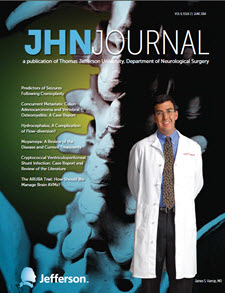Abstract
BACKGROUND
Brain arteriovenous malformations (bAVMs) are abnormal shunts that bypass the capillary bed and directly divert blood from the arterial to the venous circulation, without exchanging nutrients or dissipating the arterial blood pressure. They are thought to be congenital vascular lesions that occur during the late stages of fetal development, however the exact pathogenesis has not been elucidated yet.1 History of hemorrhage, small AVM size, high arterial feeding blood pressure, and deep venous drainage are the main risk factors that increase the likelihood of AVM rupture. According to the American Stroke Association, 1 in 200-500 people have an AVM, while 25% of AVM patients experience seizures and 50% of patients suffer intracranial hemorrhage (ICH) at some point in their lives.2 Also, 5-15% of AVM patients experience severe headaches because of the increased intracranial pressure and a similar percentage of patients exhibit neurological deficits.1 With the advent of noninvasive imaging, AVMs are being detected at an early, unruptured stage, but the optimal course of action for preventing future complications still remains uncertain. The ARUBA trial strove to determine whether medical management or interventional therapy has a better long-term outcome for patients with unruptured AVMs. While it provides important data, limitations in its study design raise doubts concerning the generalizability of its findings.
The study planned to include 800 patients who were to be followed for a minimum of five and a maximum of seven years.3 They were randomly assigned to one of two groups, the interventional therapy and medical management group. Patients in the medical management group received only pharmacological therapy for the medical symptoms that they experienced (unless they developed hemorrhage or infarction, in which case they were switched into the other group). Patients in the interventional therapy group received endovascular surgery, microsurgery, or radiosurgery, with or without pharmacological therapy depending on their concurrent medical conditions. The primary hypothesis was that medical management is more effective in the treatment of patients with unruptured bAVMs, the primary endpoint was death or stroke, the secondary endpoint was the quality of life, while the functional outcome status was measured using the Rankin scale.3
Previous studies had shown that early interventional treatment in patients with ruptured bAVMs is necessary and patients did not have major future clinical problems.3 Interventional therapy includes endovascular surgery, which aims to occlude the nidus by delivering liquid embolics or embolic coils via a catheter, microsurgical resection of the AVM, or radiosurgery that induces a vascular injury response resulting in AVM obliteration within 1 or 2 years.1 A multimodal therapy that involves more than one of these interventional procedures can also be performed on certain patients. Furthermore, medical management was shown to be very effective in treating unruptured bAVMs as indicated by the very low rate of future hemorrhage. Yet, based on data from the Columbia University Medical Center, interventional treatment of ruptured AVMs had a significantly greater likelihood of hemorrhage and/or clinical impairment (Rankin score ≥2) than medical management of unruptured AVMs. It is thus imperative to compare the effectiveness of the two methods of treatment only on patients with unruptured bAVMs, since patients who present with an ICH have an already much higher risk of experiencing a subsequent ICH (hazard ratio of 3.6).4 The ARUBA trial is the first study comparing medical management to surgical care on patients with unruptured bAVMs and a Rankin score less than two.3
Recommended Citation
Mouchtouris, BS, Nikolaos; Chalouhi, MD, Nohra; Theofanis, MD, Thana; Zanaty, MD, Mario; Tjoumakaris, MD, Stavropoula l.; Rosenwasser MD, Robert H.; and Jabbour, MD, Pascal
(2014)
"The ARUBA Trial: How Should We Manage Brain AVMs?,"
JHN Journal: Vol. 9:
Iss.
2, Article 2.
DOI: https://doi.org/10.29046/JHNJ.009.2.002
Available at:
https://jdc.jefferson.edu/jhnj/vol9/iss2/2

